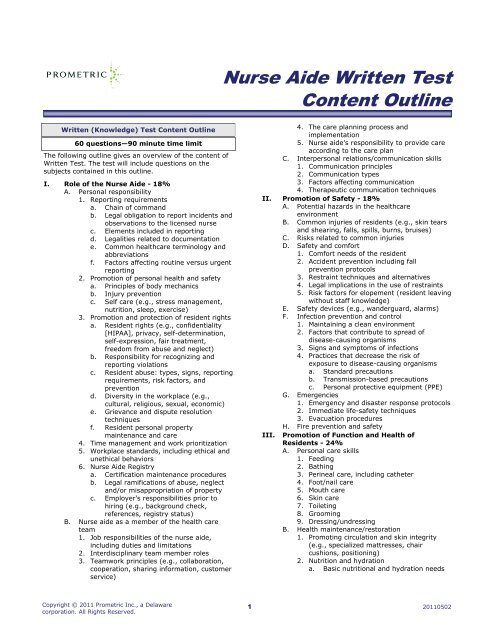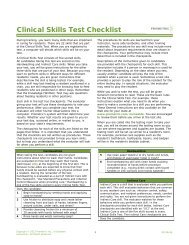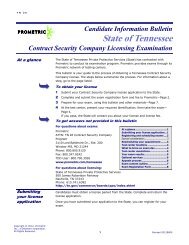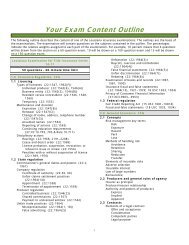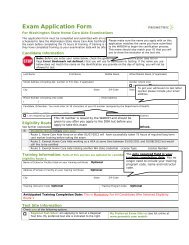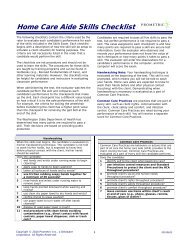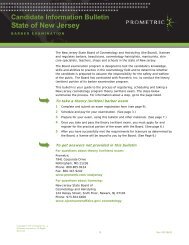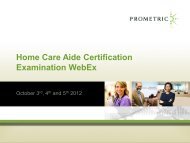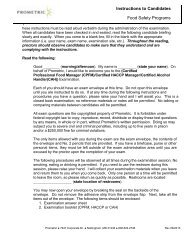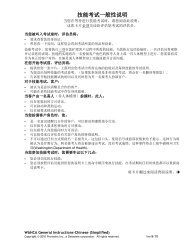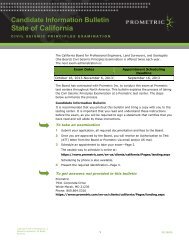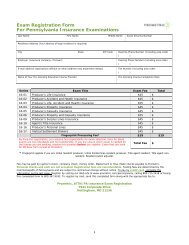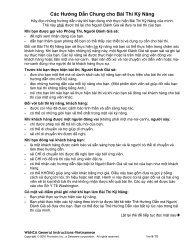Nurse Aide Written Test Content Outline - Prometric
Nurse Aide Written Test Content Outline - Prometric
Nurse Aide Written Test Content Outline - Prometric
Create successful ePaper yourself
Turn your PDF publications into a flip-book with our unique Google optimized e-Paper software.
<strong>Nurse</strong> <strong>Aide</strong> <strong>Written</strong> <strong>Test</strong><br />
<strong>Content</strong> <strong>Outline</strong><br />
<strong>Written</strong> (Knowledge) <strong>Test</strong> <strong>Content</strong> <strong>Outline</strong><br />
60 questions—90 minute time limit<br />
The following outline gives an overview of the content of<br />
<strong>Written</strong> <strong>Test</strong>. The test will include questions on the<br />
subjects contained in this outline.<br />
I. Role of the <strong>Nurse</strong> <strong>Aide</strong> - 18%<br />
A. Personal responsibility<br />
1. Reporting requirements<br />
a. Chain of command<br />
b. Legal obligation to report incidents and<br />
observations to the licensed nurse<br />
c. Elements included in reporting<br />
d. Legalities related to documentation<br />
e. Common healthcare terminology and<br />
abbreviations<br />
f. Factors affecting routine versus urgent<br />
reporting<br />
2. Promotion of personal health and safety<br />
a. Principles of body mechanics<br />
b. Injury prevention<br />
c. Self care (e.g., stress management,<br />
nutrition, sleep, exercise)<br />
3. Promotion and protection of resident rights<br />
a. Resident rights (e.g., confidentiality<br />
[HIPAA], privacy, self-determination,<br />
self-expression, fair treatment,<br />
freedom from abuse and neglect)<br />
b. Responsibility for recognizing and<br />
reporting violations<br />
c. Resident abuse: types, signs, reporting<br />
requirements, risk factors, and<br />
prevention<br />
d. Diversity in the workplace (e.g.,<br />
cultural, religious, sexual, economic)<br />
e. Grievance and dispute resolution<br />
techniques<br />
f. Resident personal property<br />
maintenance and care<br />
4. Time management and work prioritization<br />
5. Workplace standards, including ethical and<br />
unethical behaviors<br />
6. <strong>Nurse</strong> <strong>Aide</strong> Registry<br />
a. Certification maintenance procedures<br />
b. Legal ramifications of abuse, neglect<br />
and/or misappropriation of property<br />
c. Employer’s responsibilities prior to<br />
hiring (e.g., background check,<br />
references, registry status)<br />
B. <strong>Nurse</strong> aide as a member of the health care<br />
team<br />
1. Job responsibilities of the nurse aide,<br />
including duties and limitations<br />
2. Interdisciplinary team member roles<br />
3. Teamwork principles (e.g., collaboration,<br />
cooperation, sharing information, customer<br />
service)<br />
4. The care planning process and<br />
implementation<br />
5. <strong>Nurse</strong> aide’s responsibility to provide care<br />
according to the care plan<br />
C. Interpersonal relations/communication skills<br />
1. Communication principles<br />
2. Communication types<br />
3. Factors affecting communication<br />
4. Therapeutic communication techniques<br />
II. Promotion of Safety - 18%<br />
A. Potential hazards in the healthcare<br />
environment<br />
B. Common injuries of residents (e.g., skin tears<br />
and shearing, falls, spills, burns, bruises)<br />
C. Risks related to common injuries<br />
D. Safety and comfort<br />
1. Comfort needs of the resident<br />
2. Accident prevention including fall<br />
prevention protocols<br />
3. Restraint techniques and alternatives<br />
4. Legal implications in the use of restraints<br />
5. Risk factors for elopement (resident leaving<br />
without staff knowledge)<br />
E. Safety devices (e.g., wanderguard, alarms)<br />
F. Infection prevention and control<br />
1. Maintaining a clean environment<br />
2. Factors that contribute to spread of<br />
disease-causing organisms<br />
3. Signs and symptoms of infections<br />
4. Practices that decrease the risk of<br />
exposure to disease-causing organisms<br />
a. Standard precautions<br />
b. Transmission-based precautions<br />
c. Personal protective equipment (PPE)<br />
G. Emergencies<br />
1. Emergency and disaster response protocols<br />
2. Immediate life-safety techniques<br />
3. Evacuation procedures<br />
H. Fire prevention and safety<br />
III. Promotion of Function and Health of<br />
Residents - 24%<br />
A. Personal care skills<br />
1. Feeding<br />
2. Bathing<br />
3. Perineal care, including catheter<br />
4. Foot/nail care<br />
5. Mouth care<br />
6. Skin care<br />
7. Toileting<br />
8. Grooming<br />
9. Dressing/undressing<br />
B. Health maintenance/restoration<br />
1. Promoting circulation and skin integrity<br />
(e.g., specialized mattresses, chair<br />
cushions, positioning)<br />
2. Nutrition and hydration<br />
a. Basic nutritional and hydration needs<br />
Copyright © 2011 <strong>Prometric</strong> Inc., a Delaware<br />
corporation. All Rights Reserved.<br />
1 20110502
NURSE AIDE WRITTEN TEST CONTENT OUTLINE<br />
IV.<br />
b. Factors affecting dietary preferences<br />
(e.g., culture, religion)<br />
c. Factors affecting dietary intake<br />
(e.g., age related changes, condition<br />
of the mouth, ability to swallow)<br />
d. Specialized nutrition and hydration<br />
care (e.g., therapeutic diet, altered<br />
consistency)<br />
3. Sleep and rest needs<br />
4. Elimination (bowel and bladder)<br />
a. Normal elimination patterns<br />
b. Promoting elimination<br />
c. Bowel and bladder training principles<br />
5. Mobility, including bed mobility<br />
a. Promoting mobility and proper<br />
positioning<br />
b. Promoting function, including<br />
prosthetic and orthotic devices<br />
c. Safe transfer techniques<br />
d. Devices that promote mobility<br />
(e.g., braces, walkers, wheelchairs,<br />
gait belt, trapeze)<br />
e. Range of motion techniques<br />
6. Effects of immobility<br />
a. Circulation and skin integrity<br />
b. Elimination (bowel and bladder)<br />
c. Sleep and rest patterns/needs<br />
d. Self image<br />
e. Strength and endurance<br />
f. Activity tolerance<br />
g. Comfort<br />
7. Care and use of assistive devices<br />
C. Age-related changes<br />
1. Cognitive (e.g., memory) changes<br />
2. Psychosocial (e.g., relationships) changes<br />
3. Physical changes<br />
D. Psychosocial needs of residents<br />
1. Fundamental human needs<br />
(e.g., Maslow’s Hierarchy of Needs)<br />
2. Emotional support strategies<br />
3. Intervention strategies to assist residents<br />
in coping with losses and adjustments to<br />
nursing home placement (e.g., control,<br />
autonomy, privacy)<br />
Basic Nursing Care Provided by the <strong>Nurse</strong><br />
<strong>Aide</strong> - 26%<br />
A. Routine, chronic, non-life threatening<br />
situations<br />
1. Observation and reporting of physical<br />
changes<br />
a. Basic anatomy and functions of body<br />
systems<br />
b. Characteristics of body functions<br />
observable by nurse aide (e.g., vital<br />
signs, height, weight, skin integrity,<br />
elimination, circulation, dietary intake,<br />
mobility, alignment)<br />
2. Observation and reporting of behavioral<br />
changes<br />
a. Mental status changes<br />
(e.g., confusion)<br />
b. Reality orientation/validation<br />
techniques<br />
c. Emotional stress (e.g., crying,<br />
agitation, demanding-aggressive<br />
communication)<br />
d. Mood status changes (e.g., anxiety,<br />
fear, sadness)<br />
e. Defense mechanisms (e.g., denial,<br />
withdrawal, projection, blaming)<br />
B. Acute emergency situations<br />
1. Chest pain<br />
2. Cardiac arrest<br />
3. Respiratory distress<br />
4. Difficulty swallowing<br />
5. Choking/aspirations<br />
6. Vomiting<br />
7. Seizures<br />
8. Changes in mobility, speech, or other<br />
potential signs of stroke<br />
9. Diabetic situations<br />
10. Sudden onset of confusion or agitation<br />
11. Changes in level of consciousness<br />
12. Falls<br />
13. Bleeding<br />
14. Burns<br />
V. Providing Specialized Care for Residents with<br />
Changes in Health - 14 %<br />
A. Physical problems<br />
1. Common physical impairments and<br />
related care<br />
a. Sensory impairment (e.g., hearing,<br />
vision, feeling [touch])<br />
b. Speech impairment<br />
c. Changes in mobility, including<br />
paralysis<br />
d. Changes in elimination<br />
(e.g., incontinence, constipation,<br />
diarrhea, colostomy, catheters)<br />
e. Changes in nutritional needs<br />
(e.g., dietary restrictions, nausea,<br />
vomiting, tube feedings, IVs)<br />
f. Respiratory problems, including care of<br />
resident using oxygen<br />
g. Changes in skin integrity<br />
(e.g., pressure ulcers)<br />
h. Pain management<br />
2. Providing for safety, care, and comfort of<br />
residents with physical impairments<br />
3. Impact of impairment on resident safety,<br />
care, and comfort<br />
B. Psychological problems<br />
1. Common psychological impairments and<br />
related care (e.g., confusion, anxiety,<br />
depression, delirium, phobias, addiction)<br />
2. Special considerations for the safety, care,<br />
and comfort of residents with psychological<br />
impairments<br />
C. Care of the dying resident and post-mortem<br />
care<br />
1. Grief process<br />
2. Responding to the emotional needs of the<br />
resident, other residents, family and<br />
caregivers in the grief process<br />
3. Factors influencing responses to grief (e.g.,<br />
spiritual beliefs, culture, past experience)<br />
4. Physical changes and needs as death<br />
approaches<br />
5. Post-mortem care procedures<br />
2


